OCZ Vertex 3 (240GB) Review
by Anand Lal Shimpi on May 6, 2011 1:50 AM ESTAnandTech Storage Bench 2011
Last year we introduced our AnandTech Storage Bench, a suite of benchmarks that took traces of real OS/application usage and played them back in a repeatable manner. I assembled the traces myself out of frustration with the majority of what we have today in terms of SSD benchmarks.
Although the AnandTech Storage Bench tests did a good job of characterizing SSD performance, they weren't stressful enough. All of the tests performed less than 10GB of reads/writes and typically involved only 4GB of writes specifically. That's not even enough exceed the spare area on most SSDs. Most canned SSD benchmarks don't even come close to writing a single gigabyte of data, but that doesn't mean that simply writing 4GB is acceptable.
Originally I kept the benchmarks short enough that they wouldn't be a burden to run (~30 minutes) but long enough that they were representative of what a power user might do with their system.
Not too long ago I tweeted that I had created what I referred to as the Mother of All SSD Benchmarks (MOASB). Rather than only writing 4GB of data to the drive, this benchmark writes 106.32GB. It's the load you'd put on a drive after nearly two weeks of constant usage. And it takes a *long* time to run.
Here's a high level overview:
1) The MOASB, officially called AnandTech Storage Bench 2011 - Heavy Workload, mainly focuses on the times when your I/O activity is the highest. There is a lot of downloading and application installing that happens during the course of this test. My thinking was that it's during application installs, file copies, downloading and multitasking with all of this that you can really notice performance differences between drives.
2) I tried to cover as many bases as possible with the software I incorporated into this test. There's a lot of photo editing in Photoshop, HTML editing in Dreamweaver, web browsing, game playing/level loading (Starcraft II & WoW are both a part of the test) as well as general use stuff (application installing, virus scanning). I included a large amount of email downloading, document creation and editing as well. To top it all off I even use Visual Studio 2008 to build Chromium during the test.
Digging a little deeper, the test has 2,168,893 read operations and 1,783,447 write operations. The IO breakdown is as follows:
| AnandTech Storage Bench 2011 - Heavy Workload IO Breakdown | ||||
| IO Size | % of Total | |||
| 4KB | 28% | |||
| 16KB | 10% | |||
| 32KB | 10% | |||
| 64KB | 4% | |||
Only 42% of all operations are sequential, the rest range from pseudo to fully random (with most falling in the pseudo-random category). Average queue depth is 4.625 IOs, with 59% of operations taking place in an IO queue of 1.
Many of you have asked for a better way to really characterize performance. Simply looking at IOPS doesn't really say much. As a result I'm going to be presenting Storage Bench 2011 data in a slightly different way. We'll have performance represented as Average MB/s, with higher numbers being better. At the same time I'll be reporting how long the SSD was busy while running this test. These disk busy graphs will show you exactly how much time was shaved off by using a faster drive vs. a slower one during the course of this test. Finally, I will also break out performance into reads, writes and combined. The reason I do this is to help balance out the fact that this test is unusually write intensive, which can often hide the benefits of a drive with good read performance.
There's also a new light workload for 2011. This is a far more reasonable, typical every day use case benchmark. Lots of web browsing, photo editing (but with a greater focus on photo consumption), video playback as well as some application installs and gaming. This test isn't nearly as write intensive as the MOASB but it's still multiple times more write intensive than what we were running last year.
As always I don't believe that these two benchmarks alone are enough to characterize the performance of a drive, but hopefully along with the rest of our tests they will help provide a better idea.
The testbed for Storage Bench 2011 has changed as well. We're now using a Sandy Bridge platform with full 6Gbps support for these tests. All of the older tests are still run on our X58 platform.
AnandTech Storage Bench 2011 - Heavy Workload
We'll start out by looking at average data rate throughout our new heavy workload test:

The breakdown of reads vs. writes tells us more of what's going on:
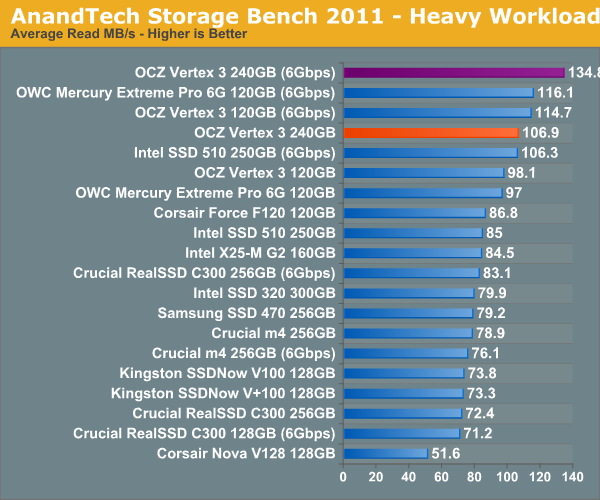
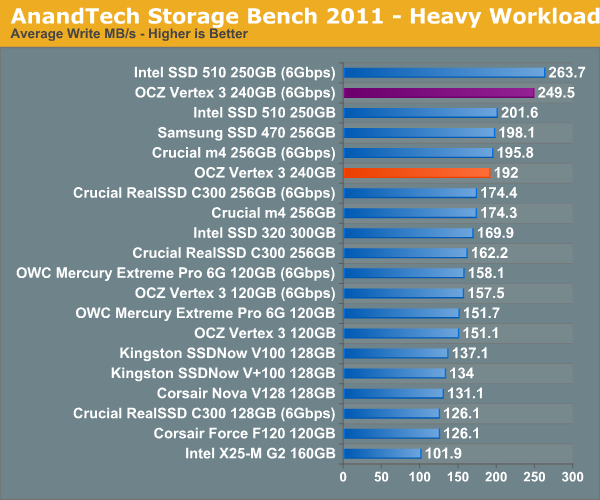
The next three charts just represent the same data, but in a different manner. Instead of looking at average data rate, we're looking at how long the disk was busy for during this entire test. Note that disk busy time excludes any and all idles, this is just how long the SSD was busy doing something:
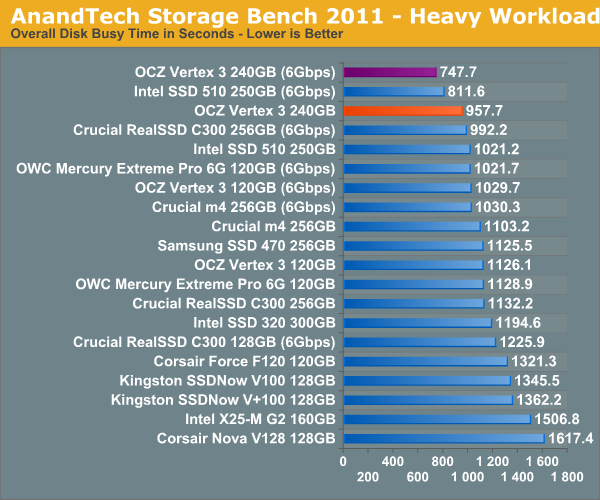
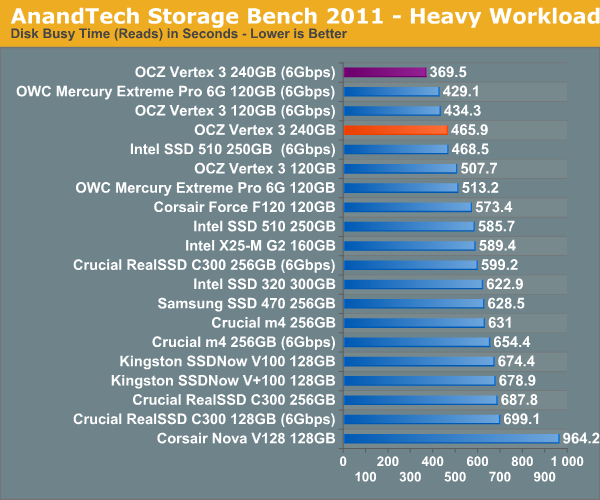
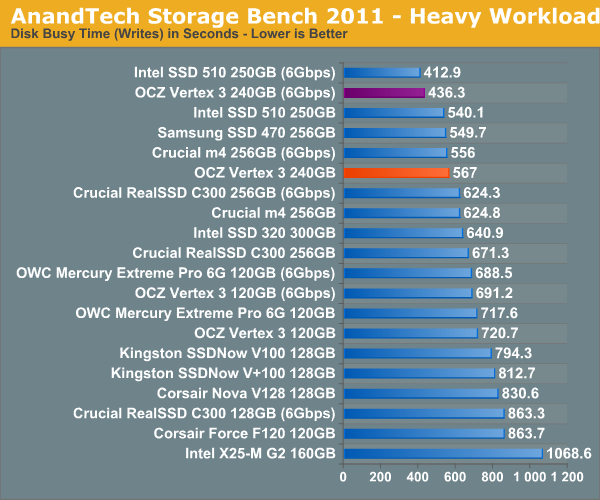










90 Comments
View All Comments
Just3r1d7 - Saturday, May 7, 2011 - link
Dear Anand,I have been carefully reading SSD articles for the past 18 months waiting for the right time to make a purchase for both my home and work PCs... The depth and breadth of SSD coverage on AnandTech has been stellar, and this latest Vertex 3 review is no exception.
It's clear that the Vertex 3 240GB is the "best performing" drive for $500. However, as other posters have noted, all of the information floating around about SSDs hasn't necessarily resulted in clear guidelines or practical recommendations.
My guess is that the "average" user isn't going to spend $500 on an SSD for their home PC... Thus, as you continue to conduct these reviews, it may be helpful to compile a table/chart to guide your dedicated readers (and anyone else who browses the site). This would also have the benefit of reducing the number of "I have Processor A, Chipset B, and Operating System C, which SSD should I buy?" questions that arise.
Here are a few examples of questions which seem to come up repeatedly and could probably be answered by a summary table of recommendations based on drives currently available in retail channels:
1. What is the best "small" capacity drive? (at any cost)
2. What is the best "low cost" drive? (at any capacity)
3. What is the best performing OS/application drive?
4. What is the best drive for non-TRIM supported OS? (e.g. WinXP or Mac)
5. What is the best (most reliable) drive for a business PC?
Just some food for thought... Keep up the great work on the SSD coverage and reviews!
-Bob
Wardrop - Saturday, May 7, 2011 - link
Anyone know when OCZ will refresh their RevoDrive line with SF2xxx controllers? I'll be getting one of them.iwod - Sunday, May 8, 2011 - link
In an ideal world, the NAND would get smaller every node shrink, and we could fit more die inside an NAND package.However with every die shrink they also double the capacity of the minimum die size. i.e from 64Gbit to 128 Gbit ... etc
If 8 Channel and 8 NAND Package being a constant factor, we are only going to get more capacity at the same price, but not lower price at lower capacity.
Is there any reason behind this?
And that is why when i see people saying i will wait for SSD to drop below $50 etc.... They are halving the price every year so i will wait a year or two before i get it. The truth is it is never going to happen. The absolute minimum BOM *equation* for SSD has stay constant for years. Unless the minimum price per NAND die is going to drop, may be what we see today is already the absolute minimum price / SSD we will ever see?
ibliblibli - Sunday, May 8, 2011 - link
A thorough review, but I'd like to understand why the HDTach charts showing the read-and-write performance before-torture, after-torture and post-TRIM are not shown. I know the average sustained writes do not change much even after torturing the drive, but I'm interested in the volatility. None of other the articles covering the latest Sand Force drives (OCZ Vertex 3 Pro/Non-Pro 240 GB Previews, OCZ Vertex 3 120 GB Review, OWC Mercury Extreme Pro 6G Review) show this data either. However, the reviews for the other new drives (Intel 510, Intel 320 and Crucial m4) includes those charts. Is there a reason for this exclusion? The information from those charts is helpful.NorthShoreExile - Monday, May 9, 2011 - link
Based on the initial review, I ordered one for my new build. It took weeks to arrive but I finally got it. All I can say is "WOW"! It is everything it claims to be.jinino - Monday, May 9, 2011 - link
Great review Anand,From the photo in the last page, I see the disk is made in Taiwan. Do you happen to know that OCZ's SSD is manufactured by the same OEM in Taiwan as the manufacturer for Intel's SSD?
alpha754293 - Monday, May 9, 2011 - link
Wonderful review on the OCZ Vertex 3 SSD.I was wondering if you might be able to run the full h2benchw benchmark on the drive?
You should be able to download it here:
http://www.heise.de/software/download/h2benchw/378... or just google it.
Can you post or email me the results please?
Thank you.
ueharaf - Tuesday, May 10, 2011 - link
what is the difference between vertex 3 and solid 3?http://www.ocztechnology.com/ocz-solid-3-sata-iii-...
sanguy - Tuesday, May 10, 2011 - link
Hi,We just received 5 Vertex 3 240GB drives for installation into some Dell E6520 laptops. We did the install but with the Vertex 3 installed we've been having random system lock-ups that require a hard boot.
We are in AHCI mode in the bios and running Windows 7x64 with the 10.1 Intel RST drivers. Drives are firmware 2.02.
We are seeing this on several laptops/drives so it's not a one off.
Drive is detected by the toolkit OCZ has available, and RST reports it correct at 6Gbps.
These are sandy bridge quad core laptops using a 6 series chipset.
Anyone seeing compatibility issues? I did find a thread at OCZ over disabling some function in the registry which we did without it solving the issue.
DanaG - Wednesday, May 11, 2011 - link
I'd say Sandforce drives are just plain buggy, if you try to do anything non-desktop with them. (Even my old Indilinx drive was more stable.)From what you're seeing, the new ones must be even worse than the old ones.
Check my comments on Page 6, and this link:
http://www.ocztechnologyforum.com/forum/showthread...